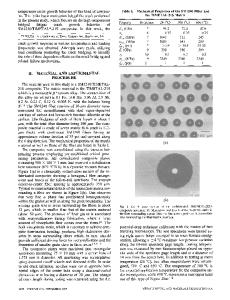Micromechanism of accelerated near-threshold fatigue crack growth in Al 2 O 3 /Al-Cu composite at elevated temperature
- PDF / 2,041,785 Bytes
- 8 Pages / 598 x 778 pts Page_size
- 29 Downloads / 333 Views
I.
INTRODUCTION
A L U M I N U M alloys reinforced with ceramic particles are currently being explored for a number of structural applications in automotive and aerospace industries, t~'2,31 They have increased stiffness, strength, fatigue, and wear properties compared to the corresponding unreinforced alloys at ambient temperature, t~-4] At elevated temperatures, the composites offer a lowthermal expansion coefficient, excellent retention of room-temperature (RT) strength, and high-creep and thermal-mechanical fatigue resistance, tS-aj These attributes make them attractive alternatives to replace conventional structural alloys in high-temperature applications. Work on the RT fatigue behavior of particulatereinforced aluminum alloy matrix composites has shown that the fatigue properties depend strongly on the mechanisms by which the fatigue crack interacts with reinforcing particles, t9-~4j At low stress intensities, cracks tend to avoid reinforcing particles, whereas at high stress intensities, cracks tend to seek out reinforcing particles. The interaction of a fatigue crack with the local microstructure results in crack trapping and formation of uncracked ligaments, both of which retard fatigue crack growth. So far, very few studies have been conducted on elevated-temperature fatigue crack growth in these composites. For applications of these composites at elevated temperatures, two additional factors must be considered. First, softening or plastic flow of the matrix can strongly influence the behavior of both the reinforcing phase and the matrix. Second, exposure at high temperature for long term can change the matrix microstructure and metal/ceramic interfacial structure by thermodynamic GANG LIU and DAPING YAO, Research Assistants, and J.K. SHANG, Assistant Professor, are with the Department of Materials Science and Engineering, University of Illinois at UrbanaChampaign, Urbana, IL 61801. Manuscript submitted September 28, 1993. METALLURGICAL AND MATERIALS TRANSACTIONS A
and kinetic forces. In many cases, it is possible to predict some of the potential microstructural changes, based on thermodynamic or kinetic principles, if the underlying cause for the change is purely thermally driven, t~5,j61 However, microstructural stability may be adversely affected by the combined action of mechanical and thermal forces during long-term service, particularly under cyclic loading conditions. In this research, fatigue crack growth behavior of a peak-aged A1203-reinforced A1-Cu matrix composite was examined at 150 ~ Although long-term exposure of the composite to the testing temperature made little change in the matrix microstructure, local overaging of the matrix was detected close to the crack tip when the fatigue crack propagated at near-threshold stress intensities. The crack tip overaging resulted in accelerated crack growth and reduction of fatigue threshold.
II.
EXPERIMENTAL PROCEDURE
Material used in the current study is a 15 vol pet A1203 particulate-reinforced A1-Cu alloy matrix composite, received from Dura
Data Loading...











